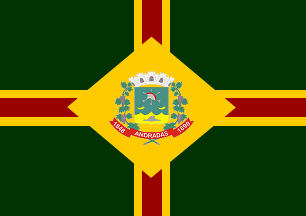 image
by Dirk Schönberger, 27 May 2010
image
by Dirk Schönberger, 27 May 2010
Last modified: 2012-02-10 by ian macdonald
Keywords: minas gerais | andradas |
Links: FOTW homepage |
search |
disclaimer and copyright |
write us |
mirrors
 image
by Dirk Schönberger, 27 May 2010
image
by Dirk Schönberger, 27 May 2010
based on http://andradas.mg.gov.br
An upright cross, dark red, fimbriated deep yellow on dark green, and in the center a deep yellow lozenge bearing the municipal arms.
Official website at
http://www.andradas.mg.gov.br. Flag is shown on the official site, at
http://andradas.mg.gov.br/portal/index.php?route=conteudo/conteudo&pag=simbolos_cidade.
Dirk Schönberger,
27 May 2010
The municipality of Andradas (37,302 inhabitants in 2010; 467 sq. km) is
located in southwestern Minas Gerais, on the border with the São Paulo State,
460 km of Belo Horizonte. The municipality is known as "Terra do
Vinho" (Wine's Land), wine-growing having been introduced by Italian
colonists in the beginning of the 20th century.
Andradas was settled, as
Samambaia, at the end of the 18th century. Samambaia was made a district in
1860 and renamed São Sebastião do Jaguary, for the patron saint of the
village, to which a chapel had been dedicated in 1845. The "vila" of Caracol,
established in 1888, was made a municipality on 22 February 1890. Made a "cidade"
in 1925, Caracol was renamed Andradas in 1928, as a tribute to Antônio
Carlos Ribeiro de Andrada (1870-1946), President of Minas Gerais in
1926-1930.
The municipal website gives the full text on the Law(s?) on
the municipal symbols, unfortunately undated. The symbols were designed by
Arcinóe Antônio Peixoto de Faria.
The flag was designed according to the
traditions of the Portuguese heraldry. The coat of arms represents the
municipal power, placed on a yellow triangle representing the seat of the
municipality. The stripes represent the municipal power spreading over the
whole municipal territory while the quarters represent the rural estates
located on the municipal territory. (Article 6) The flag should have the
same dimensions as the Brazilian national flag, that is 14 x 20 units.
(Article 7)
The coat of arms is "A Samnitic shield surmounted by an
eight-towered mural crown argent ports gules, a helmet argent feathered
gules over three crossed arrows argent, two hunting horns or, in base a
triple mantle or a snail sable. The shield supported by branches of
grapevine fructed proper, in base a scroll gules inscribed in letters argent
"ANDRADAS", flanked by the years '1848' and '1890'."
The Samnitic
shield, introduced from France to Portugal, symbolizes the Latin race as the
main colonist and founder of the Brazilian nation. The mural crown is the
heraldic representation of power; its eight towers represent a town of
second rank, that is the seat of a country ("comarca"). Vert (green) is a
symbol of honor, civility, courtesy, abundance and joy, as well as the the
symbol of hope, alluding in the greenness of the field in spring, promising
good harvest. The Roman helmet and the arrows represents St. Sebastian, the
patron saint of the town and its early namesake. Argent (silver)
represents peace, friendship, work, prosperity, purity and religious
feeling. The hunting horns recall cattle breeding, one of the sources of
income for the municipality. Or (gold) is a symbol of glory, splendor,
highness, wealth and sovereignty. Sable (black) represents the municipality.
The triple mantle with the snake represents the Sierra de Caracol (Snail's
Mountains) where the early settlements thrived. The grapevines recall that
local wine-growing is of national and international fame for the quality of
its wines. The scroll gules (red), a color symbol of commitment, patriotic
feeling, audacity, intrepidness, courage and valiance, is charged with the
place's name and its dates of establishment and political emancipation,
respectively.
http://andradas.mg.gov.br/conteudo.php?id=39 - Municipal website
Ivan Sache, 28 January 2012